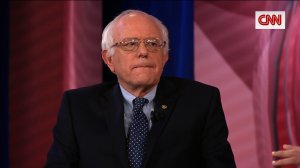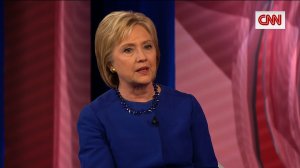WASHINGTON (CNN) — Vermont Sen. Bernie Sanders and former Secretary of State Hillary Clinton gathered in Columbia, South Carolina, for CNN’s Democratic Town Hall on Tuesday, and CNN’s Reality Check team spent the night putting their statements and assertions to the test.
The team of reporters, researchers and editors across CNN listened throughout the town hall, selected key statements and then rated them true; mostly true; true, but misleading; false; or it’s complicated.
Bernie Sanders

Reality check: Sanders on obstructionism against Obama
By Kevin Liptak, CNN
Sanders claimed that President Barack Obama has faced previously-unseen levels of resistance from Congress during his time in office.
“We have been dealing, in the last seven years, with an unprecedented level of obstructionism against President Obama,” Sanders said. “Literally — literally it turns out on the day that Obama was inaugurated, Republicans came together and said ‘What are we going to do?’ And what they concluded is we’re going to obstruct, obstruct, obstruct, make it as difficult as he could to do anything.”
He used the current battle to replace Supreme Court Associate Justice Antonin Scalia as an example of Republicans’ obstructionism.
While there are a multitude of ways to measure Congressional obstructionism, the number of filibusters provides a clear picture of lawmakers blocking action from moving forward to a final vote.
When he entered office, Obama enjoyed Democratic majorities in both the House and Senate, allowing him to pass his biggest legislative win to date, the Affordable Care Act. But as the minority party, Republicans were nonetheless were able to utilize filibusters to block action on many of Obama’s items, including judicial nominations.
According to U.S. Senate records, attempts to break filibusters reached a historic high in the 113th Congress, in place during the years 2013 and 2014. In those years, senators took 218 votes on cloture, compared to a previous high of 112 in the years 2007 and 2008, when Democrats controlled the Senate and George W. Bush was president.
Because it requires 60 votes to break a filibuster, much of the action Obama pushed for required a higher threshold than would ordinarily be needed.
That led to longer waits for judicial nominees. Congressional Research Service data show that the median number of days between a judicial nomination and confirmation rose steadily from 41 days during President Ronald Reagan’s administration to 218 days during Obama’s administration.
Democrats, when they have served in the minority in the Senate, haven’t been shy about using filibusters to block action preferred by Republicans. But historic data indicates the tactic increased during Obama’s term. By that measure, Sanders is correct.
Verdict: True.
Reality Check: Koch brothers ‘second wealthiest’ in U.S.
By Eve Bower, CNN
Sanders said that Charles and David Koch, commonly referred to as “the Koch brothers,” are the “second wealthiest family in this country. They and a few of their billionaire friends are going to spend $900 million dollars on this campaign in order to elect candidates who represent the rich and the powerful.”
Forbes magazine researched and ranked the 10 wealthiest families in the United States in 2015. According to their findings, Charles and David Koch, along with their brothers Frederick and Bill, are worth an estimated total of $86 billion. And they do indeed rank second behind the Walton family — the six heirs to Walmart founder Sam Walton — who are worth a collective $149 billion.
We rate this part of Sander’s claim true.
But the second half of Sanders’ claim is less straightforward. In January 2015, The New York Times reported that the Koch brothers had recruited a network of about 300 wealthy donors who planned to form a political organization that would spend $889 million on presidential and congressional campaigns in 2016. But a June newsletter from Koch Industries refuted this claim, saying the fundraising efforts were still underway, and that only about one-third of the sum would be spent on “presidential, congressional, state, and local races.” The remaining two-thirds was to be spent on “research and educational programs.” In an October interview with American Public Media’s “Marketplace,” Charles Koch estimated that the amount his donor network would spend on politics during 2015 and 2016 would be $250 million — less than one-third of Sanders’ claim.
On the spending by Koch’s friends, our verdict is false.
Reality Check: Sanders on voter turnout
By Sonam Vashi, CNN
In response to a question about what his revolution would look like, Sanders said, “What does it look like? Last election, November 2014, Republicans won a landslide victory, all over the country. Sixty-three percent of the American people didn’t vote. Eighty percent of young people didn’t vote.”
Was voter turnout really that low in 2014? According to the widely cited U.S. Election Project, run by University of Florida professor Michael McDonald, just 36.7% of voting-eligible Americans turned out to vote in the 2014 election, the lowest in 70 years. The term “voting-eligible” excludes people who are above 18 but are legally barred from voting, such as those convicted of felonies, those deemed mentally incapacitated, or non-citizens.
The Census Bureau found a similar turnout rate of 41.9% for that election, but Sanders’ number is correct according to at least one legitimate estimation.
In 2014, the youth voter turnout rate was 21.5%, according to the Center for Information and Research on Civil Learning and Engagement (CIRCLE), a Tufts University organization. CIRCLE defines “youth” as those aged 18 to 29, and uses demographic data that takes into account all voting-aged citizes (as opposed to sifting out felons and other citizens who are legally barred to vote). Again, the Census Bureau found similar numbers — 23.1% of voting-aged young citizens turned out to vote in 2014. But the Census defines “youth” as those aged 18 to 34, which may account for the variation. Again, Sanders is correct here.
Verdict: True.
Reality Check: Sanders on doubling of share of wealth of top 0.1%
By Tami Luhby, CNNMoney
Sanders often ticks off a list of ways that income inequality has grown in recent decades. During CNN’s Democratic Town Hall on Tuesday, he talked about the “massive transfer of wealth from the middle class and working families to the top one tenth of 1%” over the past 30 years.
“Middle class shrinking, people living in poverty, top one tenth of 1% saw a doubling, a doubling of the percentage of wealth they own,” he said.
Sanders is citing data from the well-known inequality researchers Emmanuel Saez and Gabriel Zucman of University of California, Berkeley. They found that the share of wealth of the top 0.1% has grown from 7% in 1978 to 22% in 2012. A chart in their report shows that in 1983, the share of wealth of the top 0.1% was about 9%.
So Sanders is correct. The top 0.1% has seen their share more than double over 30 years.
In case anyone is curious … there were about 160,700 taxpayers in this group, with an average wealth of $72.8 million, in 2012.
Verdict: True.
Reality Check: Sanders on unaffordable prescriptions
By Debra Goldschmidt, CNN
Sanders went after Big Pharma’s “huge profits” in talking about the need for cost-effective health care system for everyone. “One out of five Americans can’t even fill their prescriptions,” he said, referring to soaring pharmaceutical prices.
This is not the first time Sanders has made this point before, including last month at a CNN Democratic Town Hall in Iowa and again a couple of weeks ago at a CNN Democratic Town Hall in Milwaukee.
Nearly one in 10 American adults (7.8%) did not take their prescriptions as prescribed to save money, according to the 2013 National Health Information Survey, which was published last year.
The government report also found 15.1% of those surveyed asked their doctor for a less costly medication, 1.6% shopped outside of the U.S. for their medications and 4.2% reported using alternative treatments.
The survey did not include the one in five claim made by Sanders, but given that there are a number of strategies cited for Americans trying to reduce their prescription bills, we find this claim to be mostly true.
Reality Check: Sanders on Big Tobacco vs. Uruguay
By Chip Grabow, CNN
Sanders was asked by voter Dave Sprung — who said his dad had died of lung cancer — what reforms he would put in place on cigarette smoking. Sanders sympathized with Sprung, saying his father too died young and that cigarette smoking contributed to that.
Among other things, Sanders said he would take on the tobacco companies who, he said, “peddle cigarettes to kids in other parts of the world.” Sanders went on to talk about a trade issue over which Philip Morris International, one of the largest tobacco companies in the world, sued Uruguay. “And you know why they sued Uruguay?” Sanders asked, “Because their President was an oncologist, felt very strongly about this issue, worked very hard for tobacco prevention. And Phillip Morris said you are denying our company future profits.”
So, did Philip Morris actually sue the government of Uruguay? Indeed it did, indirectly. It filed with the international trade arbitration branch of the World Bank. The tobacco company took issue with Uruguay’s policy of implementing prominent health warnings that covered half a pack of cigarettes. In 2006, President Tabare Vazquez, a physician, had begun new public health initiatives to reduce smoking. He banned smoking in enclosed places, and then in 2008, introduced a new law calling for the larger health warnings on packs of cigarettes. In 2009, the Uruguayan government further increased the size of those warning labels. It also limited tobacco companies from selling more than one brand. And in 2010, Uruguay raised cigarette taxes to 70% of the pack’s price.
In 2010, Philip Morris started legal action appearing before the World Bank’s International Center for Settlement of Investment Disputes. Suing for $25 million in damages, Philip Morris argued Uruguay’s tobacco measures caused the cigarette maker to suffer “substantial losses” by restricting sales to just one brand and imposing larger warning labels preventing its trademarks being displayed properly.
According to the International Center for Settlement of Investment Disputes, the status of the case is still pending. But we have a verdict on Sanders’ claim: True.
Hillary Clinton

Clinton on closing Guantanamo Bay detention center
By Eve Bower, CNN
Clinton said, “I’ve been on record in favor of closing (the detention center at Guantanamo Bay) for a long time, since 2008.” Speaking about where detainees would be transferred, she further said, “I remember back in the ’08 election, President Obama, Senator (John) McCain and I all had the same position.”
In 2008, Obama, McCain and Clinton all campaigned on the position that the prison camp at Guantanamo, also known as Gitmo, should be closed. Therefore, we rate her first claim true. Clinton was indeed on the record throughout her 2008 run in favor of closing the facility.
Her second claim, however, that they “all had the same position” about prisoners’ fates beyond Guantanamo’s walls is false. There was significant disagreement between them while all three were in the Senate. In 2006, Congress passed the Military Commissions Act, which, among other measures, denied access to civilian courts for Guantanamo detainees. The Supreme Court later struck down that part of the act. But McCain, an Arizona Republican, had been a primary backer of the bill, and even after the Supreme Court struck down a portion of it, he expressed his concern over the ruling. Both Obama and Clinton had voted against the bill. Clinton said at the time, “in the process of accomplishing what is essential for our security, we must hold onto our values and set an example we can point to with pride and not shame.”
The three were united in their support of closing the prison at Guantanamo, but that obscures their significant disagreements on prisoner rights beyond those walls.
Reality Check: Clinton on NATO-Arab coalition in Libya
By Ryan Browne and Amy Gallagher, CNN
When Cuomo followed up on a voter’s question to Clinton by asking her about Libya, Clinton highlighted the fact that European and Arab nations had joined the U.S. during the 2011 intervention in the country. “We formed the first coalition between NATO and Arab nations,” she asserted. In the course of this campaign, many of the presidential candidates have said that such a coalition will be key to fighting ISIS, so being a part of the team assembling the first such coalition would be important experience for Clinton to tout in her quest for the presidency.
Clinton is correct in saying that the NATO-led Operation Unified Protector in Libya involved a coalition that included the Arab nations of Jordan, Qatar and the United Arab Emirates. However, this was not the first time NATO led a coalition with Arab participants. In Afghanistan in 2003, NATO took the lead of the International Security Assistance Force, which included the Arab states of Bahrain, Jordan and the United Arab Emirates.
Prior to Afghanistan, there was military cooperation between many of the same nations during the first Gulf War in 1991. At that time, 14 of the 16 NATO member nations joined forces with nine Arab states, including Bahrain, Qatar, Syria, Saudi Arabia and the U.A.E.
While Clinton was correct that the coalition in Libya included NATO and Arab nations working together, it was not the first time. Therefore, we rate her claim false.
Reality Check: Clinton on CEO pay
By Kate Grise, CNN
Clinton touted her record of consistently attacking Wall Street, despite receiving nearly $2 million in speaking fees from various banks and Wall Street groups over recent years.
“I went to Wall Street before the Great Recession. I called them out. I said what they were doing in the mortgage market was going to cause serious problems. I called for reining in CEO pay. I called for ending the loophole that lets hedge fund managers get a lower tax rate. I have been on record for a really long time,” she said.
At the beginning of the financial crisis, Clinton was running for president, and she did speak out about the issues the mortgage market may cause as early as March 2007.
“The subprime problems are now creating massive issues on Wall Street,” Clinton said during a speech on subprime lending. “It’s a serious problem affecting our housing market and millions of hard-working families.”
During the same March 2007 speech, Clinton called for expanding the role of Federal Housing Administration to insure more mortgages at better rates, providing consumers with more information and counseling, and allowing more breathing room for foreclosure.
As a senator from New York, Clinton did sponsor a bill in 2007 that aimed to implement these reforms, but it did not pass.
Clinton also released a plan to increase financial regulation and address the housing and credit crises in March 2008, just before the worst of the financial crisis hit in the fall of 2008.
Looking back on the crisis in October, Clinton wrote, “Before the crisis hit, as a senator from New York, I was alarmed by this gathering storm, and called for addressing the risks of derivatives, cracking down on abusive subprime mortgages and improving financial oversight.” She went on to lay out similar reforms to prevent the next crash in an op-ed written for Bloomberg View.
Clinton has put the issue of CEO pay at the forefront of her campaign this time around, speaking on the issue during her speech kicking off her 2016 presidential run, saying that American families are still struggling “when the average CEO makes about 300 times what the average worker makes.”
During a January 2008 interview with The New York Times, Clinton called executive-pay packages “offensive” and “wrong.”
On the loophole that allows hedge fund managers to pay lower taxes than most, Clinton has also been consistent. While campaigning for president in 2007, Clinton spoke out against the carried interest tax break that allows these managers to have their income taxed at the lower capital gains rate.
“It offends our values as a nation when an investment manager making $50 million can pay a lower tax rate on her earned income than a teacher making $50,000 pays on her income,” she said during a campaign speech back then.
Clinton has consistently repeated this claim, saying that the carried interest tax loophole is a “glaring inequity.” During this presidential campaign cycle, she has pledged to close the loophole.
We rate Clinton’s claim as true because she does indeed have a consistent position on these three issues.
Reality Check: Clinton says Obama took the most money from Wall Street but made the toughest regulations
By Sonam Vashi, CNN
Clinton said, “President Obama took an enormous amount of money, more than anybody ever had from Wall Street in 2008 when he was successful in his election, and then he turned around and pushed through the toughest regulations that we’ve seen since the Great Depression.”
During the 2008 election cycle, the Obama campaign raked in $747.8 million, including $43.7 million from the finance, insurance and real estate sector.
That’s more than the $31 million John McCain received from those industries, according to the Center for Responsive Politics, which compiles Federal Election Commission data.
Obama’s amount is also slightly more than what George W. Bush took in from those industries in 2004, but Obama’s $43.7 million would later be eclipsed by the $61 million raised by Mitt Romney in 2012, according to CRP (Clinton, for comparison, has raised about $21.7 million from the sector).
Additionally, the CRP found that individuals or PACs representing Goldman Sachs were the second highest contributors to Obama’s 2008 campaign.
As campaign contributions have grown over time, 2008 represented the most amount of money that the finance, insurance and real estate sector had given in the past 20 years.
Therefore, in raw numbers not adjusted for inflation, Clinton’s claim that the Obama campaign received the most money from Wall Street in 2008 is true.
Obama touted the 2010 Wall Street regulations as being the toughest financial reforms since the Great Depression. Many think tanks, including the Council on Foreign Relations and Bankrate, agreed. The Dodd-Frank regulations aimed to stop bailouts, enforce consumer protection and created a council that would warn the country before companies could provoke financial crises. We’re also rating that claim true.



